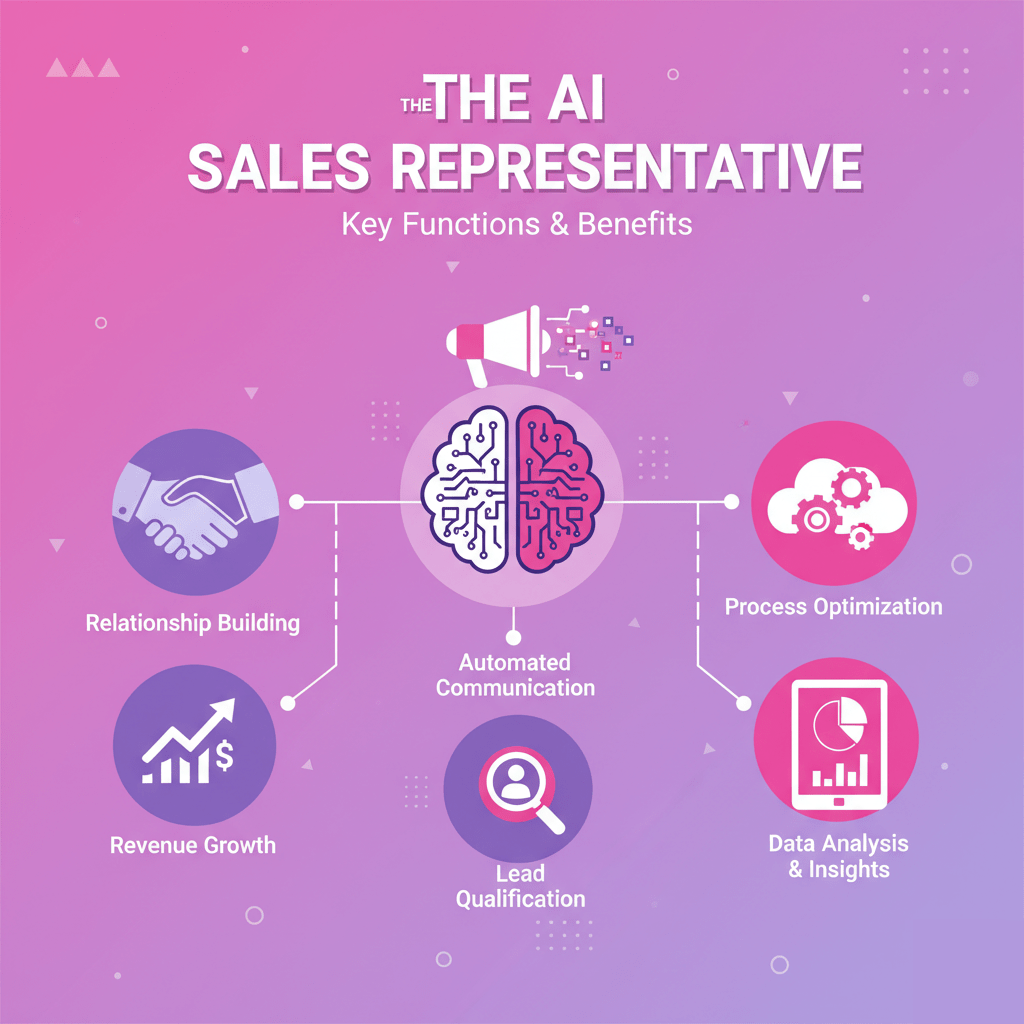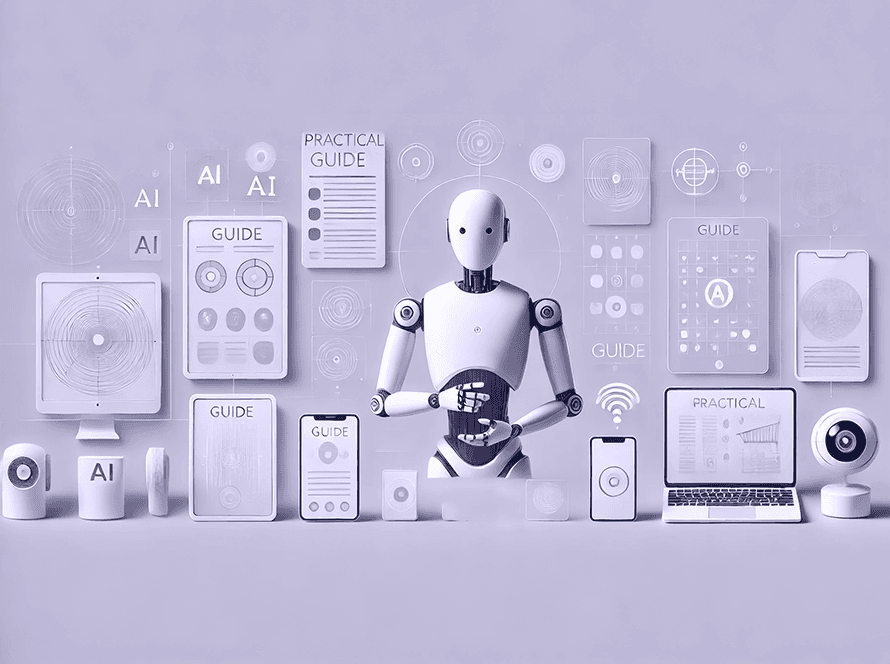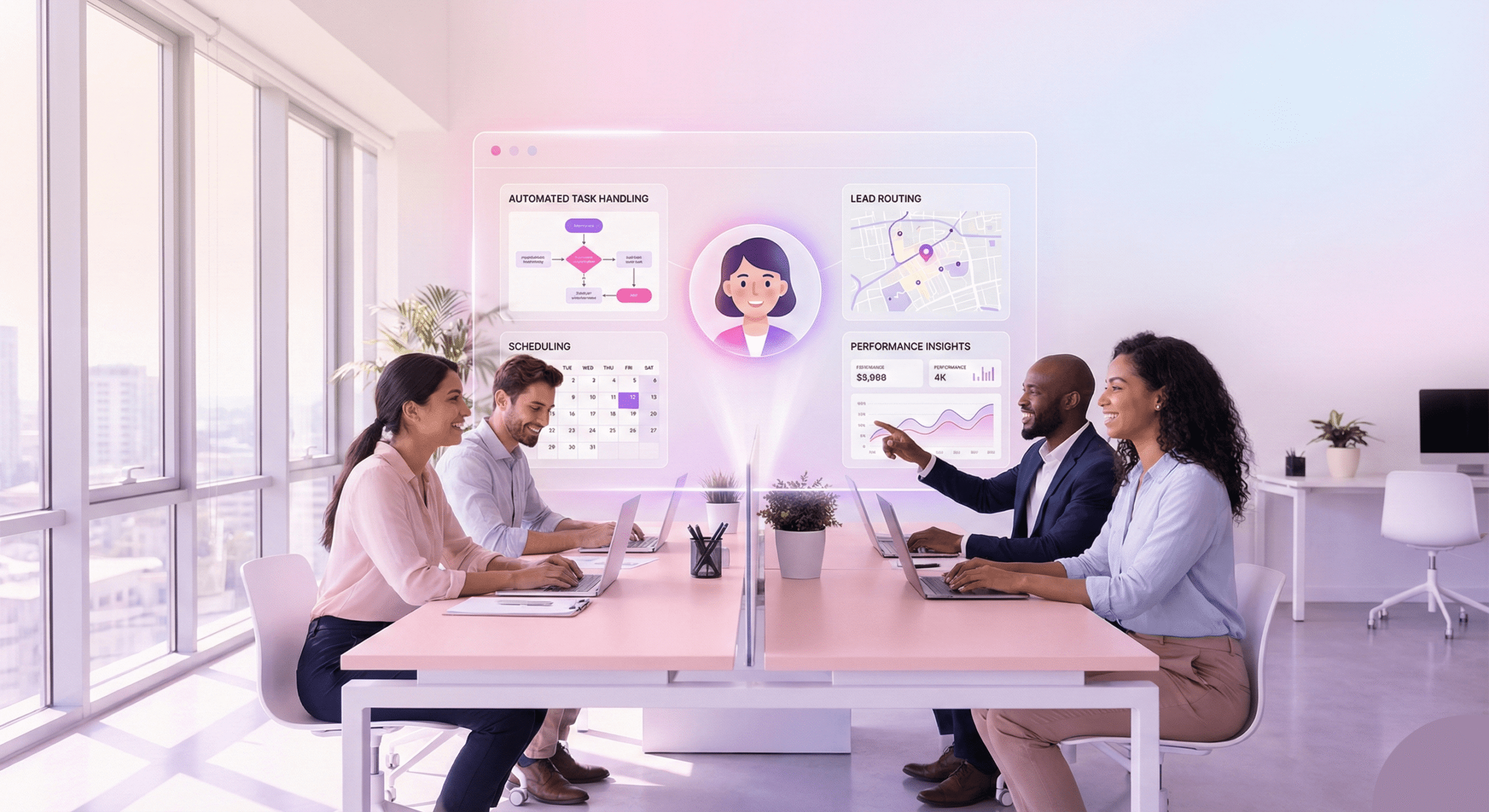“Deploying an AI sales representative instantly provides massive scalability, automating lead qualification and appointment setting to free human reps to focus only on closing deals.”
Let’s be real. Your sales team is drowning.
Your best Sales Development Reps (SDRs) and Account Executives (AEs) are spending, at best, 30% of their day actually selling. The other 70%? It’s a black hole of administrative grunt work.
They’re digging through CRM records, manually logging call notes, trying to find a good time for a demo (“Does Tuesday at two work? How about Wednesday at 4?”), and sending the same follow-up email for the thousandth time. They’re highly paid data-entry clerks who occasionally get to speak with a customer.
This is the brutal truth of modern sales: the very people you hired to build relationships and close deals are stuck doing low-value, repetitive tasks. And while they’re buried in admin, your leads are going cold. A lead that’s not contacted in the first five minutes is 21 times less likely to convert. Your team can’t possibly keep up.
But what if you could change that? What if you could build a team that never sleeps, never has a bad day, and can instantly handle 10,000 conversations at once? What if you could free your human reps to do the one thing they do best: close?
Welcome to the new era of sales. We’re not talking about a simple chatbot. We’re talking about a new kind of team member: the AI sales representative. This technology is fundamentally reshaping sales floors, and it’s time to understand precisely what it is and what it means for you.

What Exactly is an AI Sales Representative? (And What It’s Not)
First, let’s clear the air. When most people hear “AI for sales,” they picture the annoying little chatbot that pops up in the corner of a website. You know the one:
- “Hi! How can I help you today?”
- You ask: “What’s your pricing for the enterprise plan?”
- Bot: “Sorry, I didn’t get that. Here’s a link to our FAQ page.”
That is not an AI sales representative. That’s a “dumb” bot. It’s a reactive, rules-based script. It’s a glorified search bar that can’t handle real conversation. It has no goals, no memory, and no ability to drive an outcome.
An AI sales representative is something entirely different.
Think of it as an autonomous, digital employee. It’s a piece of software with a “brain” powered by sophisticated conversational AI for sales and natural language processing. It doesn’t just answer questions; it asks them. It doesn’t just react; it acts.
Here’s the key difference:
- A Chatbot is a passive receptionist. It sits at the desk and waits for someone to ask a simple question it knows the answer to.
- An AI Sales Representative is a proactive SDR. It gets a list of 10,000 leads, picks up the phone (or email), and starts prospecting. Its goal is to find a qualified lead and book a meeting.
This virtual sales assistant can be deployed in many ways. It can live on your website to instantly engage and qualify inbound traffic. More powerfully, it can run entire outbound sales AI campaigns, emailing prospects, understanding their replies, handling objections, and booking demos directly onto your team’s calendar.
It understands context. It remembers past conversations. It knows when to push, when to back off, and when to hand the conversation over to a human. It’s the ultimate tool for SDR automation, and it’s already here.
Core Benefit 1: The Scalability Tsunami
This is the first and most staggering benefit of an AI sales representative. Your human team has hard limits. An AI rep does not.
The Human Bottleneck
Think about your best SDR. Let’s call her Sarah. Sarah is a rockstar. She can make 100 dials in a day. Out of those, she might have 10 meaningful conversations. Out of those 10, she might book one or two qualified appointments.
That’s a great day! But Sarah is still just one person. She needs to sleep, eat lunch, and take breaks. She can only talk to one person at a time. If you want to double your output, you have to hire another Sarah, train her for three months, and hope she’s just as good.
This linear scaling is expensive and slow.
The AI Advantage: 1-to-10,000
Now, think about an AI sales representative.
You give it a list of 50,000 leads from a recent tradeshow. A human team would take months to work that list. The AI rep starts immediately.
It doesn’t just send a blast. It sends 50,000 personalized first-touch emails, utilizing merge tags and custom snippets. But here’s the magic: it can then handle 10,000 simultaneous conversations when the replies come in.
It can be talking to a CEO in Tokyo, a VP in New York, and a manager in London simultaneously. It instantly understands their replies:
- Lead 1: “I’m interested, but the timing is bad. Check back in Q3.”
- AI: “Understood. I’ll make a note to reach out in July. Thanks.” (AI automatically schedules the task).
- Lead 2: “We already use your competitor, X.”
- AI: “Thanks for letting me know. A lot of our customers used to use X. They found that our platform offered [Specific Value Prop]. Are you open to a 15-minute comparison next week?” (AI executes the pre-loaded objection-handling script).
- Lead 3: “This sounds great. When can we see a demo?”
- AI: “Happy to set that up. My colleague, David (your AE), is free on Tuesday at 2 PM or Thursday at 10 AM. Do either of those work for you?” (AI handles the automated appointment setting).
This is a 24/7 sales agent. While your team is asleep, your squad is qualifying leads in other time zones. While your team is in a meeting, it’s responding to inbound requests in seconds.
This is the end of the “5-minute rule” for lead response. We’re now in the era of the 5-second rule. Platforms designed for this, like SalesCloser.ai, are built to handle this massive scale. You don’t just “run a campaign”; you unleash an autonomous sales force that can work a list of 100,000 prospects as easily as a list of 100. The bottleneck is wholly removed.
Core Benefit 2: Unlocking Superhuman Efficiency
The second biggest win is taking all that “grunt work” we talked about and automating it completely. This is about giving your human team their time back. This is SDR automation and AI sales automation in its purest form.
Let’s break down the tasks an AI rep takes off your plate.
1. Automated Lead Qualification (The “Virtual BDR”)
Not all leads are created equal. A significant portion of your team’s time is wasted talking to people who are a poor fit—those in the wrong company size, without a budget, or without authority.
An AI sales rep acts as the perfect filter. It’s the ultimate lead qualification bot, but with a brain.
You can “teach” it to your exact criteria. Let’s say you use the BANT framework (Budget, Authority, Need, Timeline):
- Human Rep: Has to ask these questions, notes them down, might forget one, and then manually updates the CRM.
- AI Rep: Seamlessly weaves these questions into a natural email or chat conversation.
- “To make sure I connect you with the right person, are you the one who typically evaluates new software?” (Authority)
- “What solution are you using for this problem right now?” (Need)
- “Are you working with a specific budget for this project?” (Budget)
- “What’s your timeline for making a decision?” (Timeline)
The AI gets all the answers before it ever books a meeting. When your Account Executive shows up for the demo, they’re not walking in blind. They have a fully qualified, high-intent prospect who’s ready to talk specifics. The AI has teed up the perfect shot.
2. Flawless Automated Appointment Setting
This is one of the most painful parts of sales. The endless “calendar tennis.”
You: “Are you free Tuesday?”
Them: “No, how about Wednesday?”
You: “I’m booked. Thursday morning?”
Them: (Doesn’t reply for two days)
By the time you find a slot, the lead’s initial excitement is gone.
An AI sales representative solves this problem once and for all. It connects directly to your sales team’s calendars (e.g., Google, Outlook 365).
When a lead says “I’m interested,” the AI takes over:
- AI: “Great. To make this easy, I’ve checked my colleague’s calendar. She’s available [Time 1] or [Time 2]. You can also grab any time that works for you here: [Calendly Link].”
- Lead: “Let’s do [Time 1].”
- AI: “Perfect. I’ve just sent you a calendar invitation with the meeting details. Look forward to it!”
The AI does all of this instantly. It sends the invite, adds the prospect, includes the Zoom link, and logs the new meeting in the CRM. Your human rep just… sees a new demo pop up on their calendar. This single feature is one of the most potent sales productivity tools you can deploy.
3. The End of Manual Data Entry
Ask any salesperson what they hate most about their job, and 9 out of 10 will say “updating the CRM.” It’s tedious, and they often forget, which means your sales data is a mess.
An AI sales rep is the CRM. Every single conversation, email, reply, and outcome is logged automatically and in real-time.
- The AI emails a lead. (Logged in CRM).
- The lead replies with an objection. (Logged in CRM, and the lead is tagged “Objection – Competitor”).
- The AI overcomes the objection. (Logged in CRM).
- The lead agrees to a meeting. (Logged in CRM, and the lead status is changed to “Meeting Booked”).
Your dashboards in Salesforce or HubSpot suddenly become 100% accurate. You have perfect visibility into your pipeline, not because you pestered your team to “update their notes,” but because the AI did it for them.
This is what a virtual sales assistant should be. Platforms like SalesCloser.ai are designed around this principle. The AI isn’t just a separate tool; it’s the engine driving your core sales process. It handles qualification, books the meeting, and manages all administrative tasks, freeing your team to focus on building rapport and closing the deal.
Core Benefit 3: The Power of Perfect Consistency
Humans are not robots. That’s our greatest strength in a complex closing scenario, but it’s our most significant weakness in top-of-funnel prospecting.
- Your best SDR, Sarah, is on fire on Monday. She’s creative and hits every talking point.
- By Friday afternoon, she’s tired. She’s had a few rejections. She gets lazy. She skips a key discovery question. She fumbles an objection. She misses an opportunity.
This inconsistency is a silent killer for sales teams. You also have the “new hire” problem. A new SDR typically takes three to six months to ramp up and learn the playbook.
An AI sales representative solves this problem completely.
The Perfect Pitch, Every Single Time
You “train” an AI rep once. You load it with your absolute best, A-plus-player knowledge.
- Your best value propositions? Loaded.
- Your proven objection-handling scripts? Loaded.
- Your brand’s tone of voice? Loaded.
- Your case studies for specific industries? Loaded.
From that moment on, the AI executes that playbook perfectly, every single time, at a scale of thousands. It never gets tired. It never has a “bad day.” It never gets nervous talking to a C-level executive. It never forgets to ask the key qualifying question.
If you have five AI reps, they are all instantly as good as your #1 human rep. If you need to “hire” 50 more, you don’t go through a recruiting process. You just clone the AI. Your “ramp time” drops from three months to three seconds.
Instant A/B Testing and Optimization
This consistency also allows you to test and improve your messaging with scientific precision.
With a human team, if you want to test a new opening line, it’s hard to get clean data. Sarah might say it differently from Mark. Mark might only try it on a few calls.
With an AI, you can say:
- AI Group A (10,000 leads): Use opening line “We help companies like yours save 30% on costs.”
- AI Group B (10,000 leads): Use opening line “We help companies like yours boost revenue by 15%.”
Within 24 hours, you’ll have a statistically significant answer. “Group B’s opener got a 40% higher response rate. Great. Effective immediately, all AIs will now use the Group B opener.”
This level of control and precision is impossible with a team consisting solely of humans. Again, platforms like SalesCloser.ai make this easy. You don’t need to be a data scientist. You can input your different “playbooks” and “battle cards,” and the AI will execute them flawlessly, telling you which one actually works. This is how you stop guessing and start knowing what your prospects want to hear.
Core Benefit 4: Data-Driven Insights You Can Actually Use
The final piece of the puzzle is data. For most sales teams, “data” is a messy collection of subjective notes in a CRM. It’s “gut feel.”
Sales Manager: “Why are we losing in the finance sector?”
SDR: “I don’t know, I just get a sense they think we’re too expensive.”
That’s not good enough.
When an AI sales representative handles your first 50,000 conversations, you don’t have “a sense.” You have a database. Every single word of every single conversation is captured, structured, and analyzed.
This is a data goldmine. You can now ask and answer critical business questions:
- TAccurateObjection Analysis: “What are the exact top 3 objections we get, by percentage?”
- The AI indicates that 42% say “Too expensive,” 29% say “Happy with competitor,” and 18% say “No budget right now.”
- Your Action: You can now retrain the AI (and your human team) with new, specific rebuttals for those exact objections.
- Product/Market Fit Feedback: “What features are prospects asking for?”
- The AI tells you: “15% of all prospects in the healthcare industry asked if we are HIPAA compliant.”
- Your Action: You send this data directly to the product team. This is no longer an anecdote; it’s a hard statistic.
- Messaging Effectiveness: “Which value proposition gets the most positive replies?”
- The AI indicates that when we mention our ’24/7 support,’ we see a 22% lift in positive sentiment compared to when we say our ‘easy UI.’
- Your Action: Inform your marketing team to update the website and all ad copy to feature 24/7 support prominently.
- Lead Source Quality: “Are the leads from the ‘SaaS B2B’ webinar better than the ‘Finance 101’ e-book?”
- The AI tells you: “The webinar leads had a 12% meeting-booked rate, while the e-book leads only had a 3% rate.”
- Your Action: You double down on your webinar budget and cut the e-book spend.
This is a real-time, 100% accurate feedback loop between the market and your business. The AI sales representative isn’t just a seller; it’s your most powerful market intelligence tool.
The analytics dashboards in tools like SalesCloser.ai are specifically designed for this purpose. They don’t just show “emails sent.” They display sentiment analysis, objection trends, and which playbooks are yielding the most success. You stop flying blind and start making data-driven decisions.
The Future of Sales is Already Here
The world of sales has changed. “Hustle” and “grinding” are no longer enough. The winning teams won’t be the ones who make the most calls; they’ll be the ones who automate the most tasks and use their human-to-human time most effectively.
The AI sales representative is the single most powerful sales productivity tool to emerge in the last decade. It’s not a gimmick. It represents a fundamental shift in the structure of sales teams.
It gives you:
- Massive Scalability: Go from 100 calls a day to 10,000 conversations an hour.
- Extreme Efficiency: Automate lead qualification, appointment setting, and all your admin work.
- Perfect Consistency: Deploy your best sales pitch, every time, without fail.
- Deep Data Insights: Finally understand why you’re winning and losing deals.
Your best salespeople are creative, empathetic, and strategic. They’re closers. So why are they still spending their days doing robot work?
It’s time to let the robots do the robot work.
It’s time to let your sellers sell.
FAQs: Answering the Tough Questions About AI Sales Reps
1. Will an AI sales representative replace my SDR team?
This is the number one fear, and the answer is no. It changes the SDR’s job. It replaces the worst parts of their job.
Think about it: do you really want your smart, expensive, human SDRs spending their day copying and pasting emails and leaving voicemails? No.
The AI handles 99% of “no’s,” “not interested,” and “maybe laters.” It sifts through the noise to find the 1% of “yes, let’s talk.”
Your human SDRs are now promoted.
- They stop being “robots” and start being “handlers” or “managers.” They manage the AI, launch new campaigns, and analyze the data.
- They become full-cycle AEs faster because they now only spend their time on high-value, qualified demo calls.
- The AI acts as the ultimate virtual sales assistant, making your human team 10x more productive.
2. What happens when the AI gets a complex or angry question it can’t handle?
This is a critical feature of any good conversational AI for a sales platform. A well-designed AI knows its own limits.
When it encounters a question it’s not trained for, a high-intent buying signal, or an angry customer, it doesn’t try to “fake it.” It instantly flags the conversation and routes it to a human.
In platforms like SalesCloser.ai, this is referred to as a “human-in-the-loop” exception. The human rep gets a notification, can review the entire conversation history in a second, and then jump in to take over personally. The handoff is seamless. The AI does 95% of the work, and the human handles the 5% that truly requires a human touch.
3. Is this just a sophisticated spam bot?
No. Spam is sending 100,000 identical, impersonal emails and praying.
An outbound sales AI is about personalization at scale. The AI connects to your CRM and can retrieve personal details for each prospect, including their name, company, title, industry, and recent company news.
The email it sends to a VP of Marketing at a tech company will be completely different from the one it sends to a Director of Operations at a manufacturing plant. It’s not spam; it’s an excellently targeted, 1-to-1 conversation, happening thousands of times at once.
4. How hard is this to set up? Do I need a team of engineers?
Ten years ago, yes. Today, no.
Modern platforms are built for sales leaders, not developers. The setup process is about training, not coding.
You typically:
- Connect Your Tools: Authorize your email (Gmail/Outlook), CRM (Salesforce/HubSpot), and calendar.
- Train the AI: You feed it your “knowledge base.” This is as simple as uploading documents, such as your playbooks, case studies, FAQ page, and battle cards against competitors.
- Set the Goal: You define the “persona” (e.g., “be a helpful BDR named ‘Alex'”) and the “goal” (e.g., “book a 30-minute demo with an AE for any lead with 500+ employees”).
- Launch: You provide a lead list and click “Go.”
The AI learns your business and your voice, and then it starts working.
5. What’s the real difference between a “lead qualification bot” and an “AI sales representative”?
A lead qualification bot is typically a passive, inbound tool. It resides on your website and interacts with visitors. It’s a “catcher.”
An AI sales representative is an active, outbound agent. It’s a “hunter.” It takes a list of cold or warm leads and initiates the conversation to generate new business. It can also handle the inbound role, but its true power lies in its ability to hunt for new opportunities proactively.








